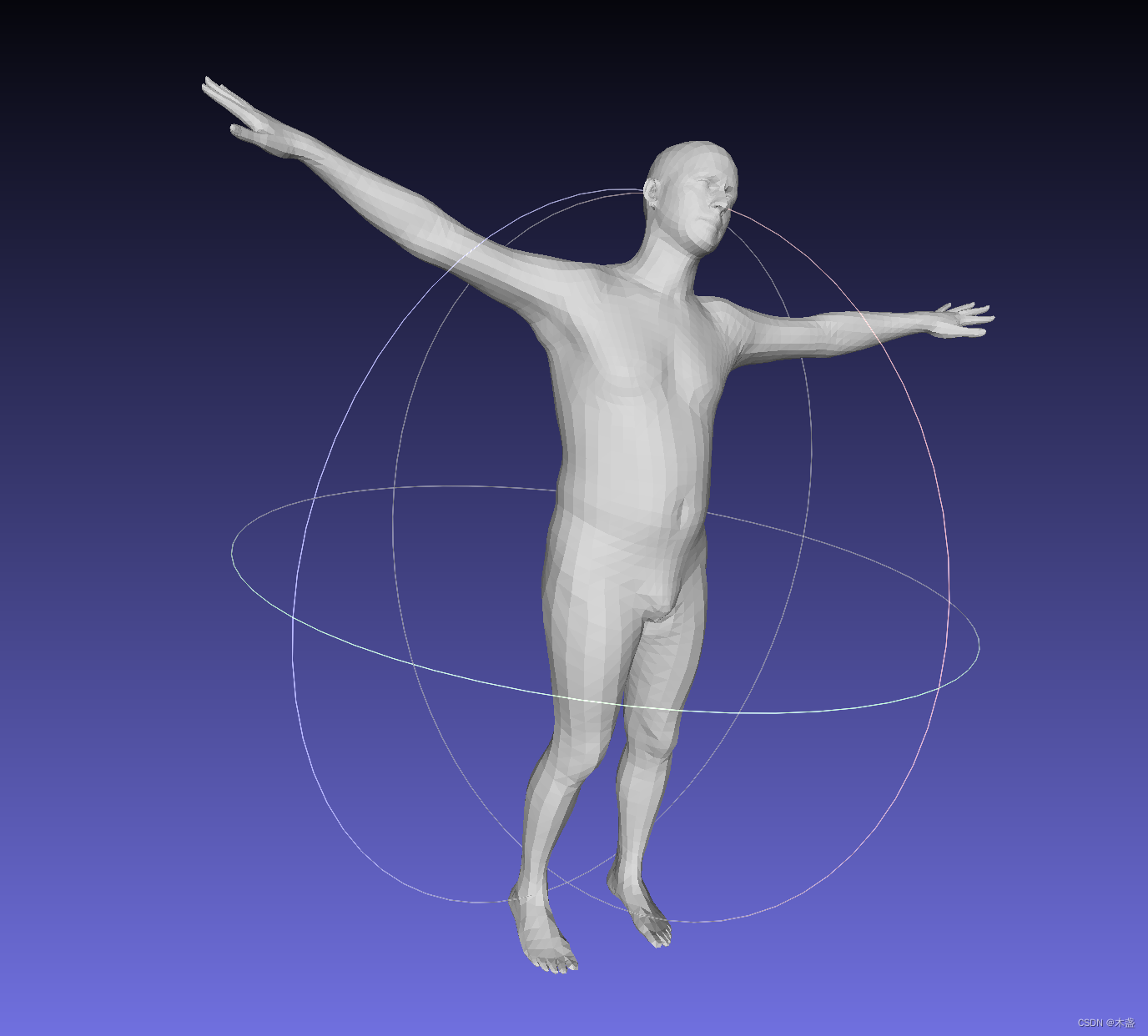SMPL是馬普所提出的經典人體模型,目前已成為姿態估計、人體重建等領域必不可少的基礎先驗。SMPL基于蒙皮和BlendShape實現,從數千個三維人體掃描結果得來,后通過PCA統計學習得來。
論文:SMPL: A Skinned Multi-Person Linear Model
主頁:https://smpl.is.tue.mpg.de/index.html
簡單來說:SMPL是多個人體模型,這些人體模型的形狀、姿態都可以被參數化表示。
SMPL參數一般分為兩組:體型參數 β ? \bold{\vec{\beta}} β?和姿態參數 θ ? \bold{\vec{\theta}} θ。前者決定人體的高矮胖瘦身材比例等,后者決定人體具體姿態。我們從下圖即可看出它們的作用:

(圖片來自鏈接)
最初始版本(v1.0.0)的SMPL模型有兩種性別,對應兩個人體模型。每個人體模型有10個體型參數+24x3=72個姿態參數;所以,我們用10+72=82個數就可以表示一個SMPL人體。
隨便地,我們生成一組參數:
pose = (np.random.rand((24, 3)) - 0.5) * 0.4 # 24x3=72
beta = (np.random.rand((10,)) - 0.5) * 0.06
這里的pose表示姿態參數 θ ? \bold{\vec{\theta}} θ,beta表示體型參數 β ? \bold{\vec{\beta}} β?。于是,這一smpl人體可以被生成出來——我們可以用obj文件表示,用MeshLab即可打開:

什么?你問我怎么得到這個obj文件的?
腳本放在下面,按需自取:
import numpy as np
import pickleclass SMPLModel():def __init__(self, model_path):"""SMPL model.Parameter:---------model_path: Path to the SMPL model parameters, pre-processed by`preprocess.py`."""with open(model_path, 'rb') as f:params = pickle.load(f)self.J_regressor = params['J_regressor']self.weights = params['weights']self.posedirs = params['posedirs']self.v_template = params['v_template']self.shapedirs = params['shapedirs']self.faces = params['f']self.kintree_table = params['kintree_table']id_to_col = {self.kintree_table[1, i]: i for i in range(self.kintree_table.shape[1])}self.parent = {i: id_to_col[self.kintree_table[0, i]]for i in range(1, self.kintree_table.shape[1])}self.pose_shape = [24, 3]self.beta_shape = [10]self.trans_shape = [3]self.pose = np.zeros(self.pose_shape)self.beta = np.zeros(self.beta_shape)self.trans = np.zeros(self.trans_shape)self.verts = Noneself.J = Noneself.R = Noneself.update()def set_params(self, pose=None, beta=None, trans=None):"""Set pose, shape, and/or translation parameters of SMPL model. Verices of themodel will be updated and returned.Parameters:---------pose: Also known as 'theta', a [24,3] matrix indicating child joint rotationrelative to parent joint. For root joint it's global orientation.Represented in a axis-angle format.beta: Parameter for model shape. A vector of shape [10]. Coefficients forPCA component. Only 10 components were released by MPI.trans: Global translation of shape [3].Return:------Updated vertices."""if pose is not None:self.pose = poseif beta is not None:self.beta = betaif trans is not None:self.trans = transself.update()return self.vertsdef update(self):"""Called automatically when parameters are updated."""# how beta affect body shapev_shaped = self.shapedirs.dot(self.beta) + self.v_template# joints locationself.J = self.J_regressor.dot(v_shaped)pose_cube = self.pose.reshape((-1, 1, 3))# rotation matrix for each jointself.R = self.rodrigues(pose_cube)I_cube = np.broadcast_to(np.expand_dims(np.eye(3), axis=0),(self.R.shape[0]-1, 3, 3))lrotmin = (self.R[1:] - I_cube).ravel()# how pose affect body shape in zero posev_posed = v_shaped + self.posedirs.dot(lrotmin)# world transformation of each jointG = np.empty((self.kintree_table.shape[1], 4, 4))G[0] = self.with_zeros(np.hstack((self.R[0], self.J[0, :].reshape([3, 1]))))for i in range(1, self.kintree_table.shape[1]):G[i] = G[self.parent[i]].dot(self.with_zeros(np.hstack([self.R[i],((self.J[i, :]-self.J[self.parent[i],:]).reshape([3,1]))])))G = G - self.pack(np.matmul(G,np.hstack([self.J, np.zeros([24, 1])]).reshape([24, 4, 1])))# transformation of each vertexT = np.tensordot(self.weights, G, axes=[[1], [0]])rest_shape_h = np.hstack((v_posed, np.ones([v_posed.shape[0], 1])))v = np.matmul(T, rest_shape_h.reshape([-1, 4, 1])).reshape([-1, 4])[:, :3]self.verts = v + self.trans.reshape([1, 3])def rodrigues(self, r):"""Rodrigues' rotation formula that turns axis-angle vector into rotationmatrix in a batch-ed manner.Parameter:----------r: Axis-angle rotation vector of shape [batch_size, 1, 3].Return:-------Rotation matrix of shape [batch_size, 3, 3]."""theta = np.linalg.norm(r, axis=(1, 2), keepdims=True)# avoid zero dividetheta = np.maximum(theta, np.finfo(r.dtype).eps)r_hat = r / thetacos = np.cos(theta)z_stick = np.zeros(theta.shape[0])m = np.dstack([z_stick, -r_hat[:, 0, 2], r_hat[:, 0, 1],r_hat[:, 0, 2], z_stick, -r_hat[:, 0, 0],-r_hat[:, 0, 1], r_hat[:, 0, 0], z_stick]).reshape([-1, 3, 3])i_cube = np.broadcast_to(np.expand_dims(np.eye(3), axis=0),[theta.shape[0], 3, 3])A = np.transpose(r_hat, axes=[0, 2, 1])B = r_hatdot = np.matmul(A, B)R = cos * i_cube + (1 - cos) * dot + np.sin(theta) * mreturn Rdef with_zeros(self, x):"""Append a [0, 0, 0, 1] vector to a [3, 4] matrix.Parameter:---------x: Matrix to be appended.Return:------Matrix after appending of shape [4,4]"""return np.vstack((x, np.array([[0.0, 0.0, 0.0, 1.0]])))def pack(self, x):"""Append zero matrices of shape [4, 3] to vectors of [4, 1] shape in a batchedmanner.Parameter:----------x: Matrices to be appended of shape [batch_size, 4, 1]Return:------Matrix of shape [batch_size, 4, 4] after appending."""return np.dstack((np.zeros((x.shape[0], 4, 3)), x))def save_to_obj(self, path):"""Save the SMPL model into .obj file.Parameter:---------path: Path to save."""with open(path, 'w') as fp:for v in self.verts:fp.write('v %f %f %f\n' % (v[0], v[1], v[2]))for f in self.faces + 1:fp.write('f %d %d %d\n' % (f[0], f[1], f[2]))if __name__ == '__main__':smpl = SMPLModel('./model.pkl') # python SMPL modelnp.random.seed(9608)pose = (np.random.rand(*smpl.pose_shape) - 0.5) * 0.4 # (24, 3)beta = (np.random.rand(*smpl.beta_shape) - 0.5) * 0.06 # (10, )trans = np.zeros(smpl.trans_shape)smpl.set_params(beta=beta, pose=pose, trans=trans)smpl.save_to_obj('./smpl_np.obj')
代碼來源:https://github.com/CalciferZh/SMPL






)

引入aar包報錯問題)

)

)


)



